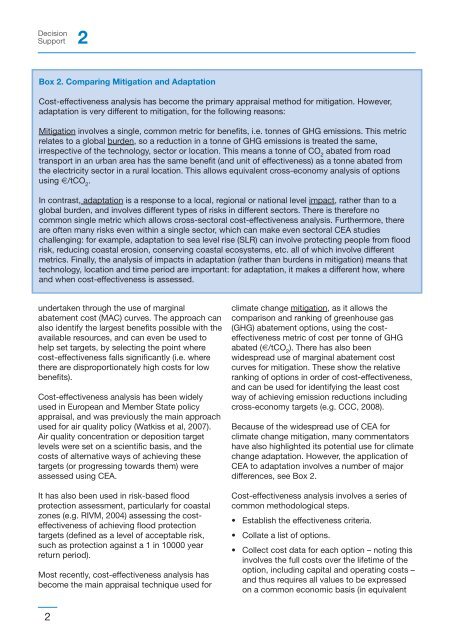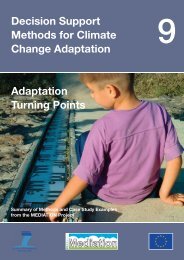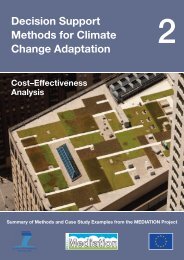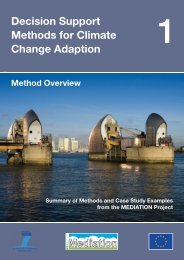Download all Technical Policy Briefing Notes in a single ... - Mediation
Download all Technical Policy Briefing Notes in a single ... - Mediation
Download all Technical Policy Briefing Notes in a single ... - Mediation
- No tags were found...
You also want an ePaper? Increase the reach of your titles
YUMPU automatically turns print PDFs into web optimized ePapers that Google loves.
DecisionSupport 2Box 2. Compar<strong>in</strong>g Mitigation and AdaptationCost-effectiveness analysis has become the primary appraisal method for mitigation. However,adaptation is very different to mitigation, for the follow<strong>in</strong>g reasons:Mitigation <strong>in</strong>volves a s<strong>in</strong>gle, common metric for benefits, i.e. tonnes of GHG emissions. This metricrelates to a global burden, so a reduction <strong>in</strong> a tonne of GHG emissions is treated the same,irrespective of the technology, sector or location. This means a tonne of CO 2abated from roadtransport <strong>in</strong> an urban area has the same benefit (and unit of effectiveness) as a tonne abated fromthe electricity sector <strong>in</strong> a rural location. This <strong>all</strong>ows equivalent cross-economy analysis of optionsus<strong>in</strong>g €/tCO 2.In contrast, adaptation is a response to a local, regional or national level impact, rather than to aglobal burden, and <strong>in</strong>volves different types of risks <strong>in</strong> different sectors. There is therefore nocommon s<strong>in</strong>gle metric which <strong>all</strong>ows cross-sectoral cost-effectiveness analysis. Furthermore, thereare often many risks even with<strong>in</strong> a s<strong>in</strong>gle sector, which can make even sectoral CEA studiesch<strong>all</strong>eng<strong>in</strong>g: for example, adaptation to sea level rise (SLR) can <strong>in</strong>volve protect<strong>in</strong>g people from floodrisk, reduc<strong>in</strong>g coastal erosion, conserv<strong>in</strong>g coastal ecosystems, etc. <strong>all</strong> of which <strong>in</strong>volve differentmetrics. F<strong>in</strong><strong>all</strong>y, the analysis of impacts <strong>in</strong> adaptation (rather than burdens <strong>in</strong> mitigation) means thattechnology, location and time period are important: for adaptation, it makes a different how, whereand when cost-effectiveness is assessed.undertaken through the use of marg<strong>in</strong>alabatement cost (MAC) curves. The approach canalso identify the largest benefits possible with theavailable resources, and can even be used tohelp set targets, by select<strong>in</strong>g the po<strong>in</strong>t wherecost-effectiveness f<strong>all</strong>s significantly (i.e. wherethere are disproportionately high costs for lowbenefits).Cost-effectiveness analysis has been widelyused <strong>in</strong> European and Member State policyappraisal, and was previously the ma<strong>in</strong> approachused for air quality policy (Watkiss et al, 2007).Air quality concentration or deposition targetlevels were set on a scientific basis, and thecosts of alternative ways of achiev<strong>in</strong>g thesetargets (or progress<strong>in</strong>g towards them) wereassessed us<strong>in</strong>g CEA.It has also been used <strong>in</strong> risk-based floodprotection assessment, particularly for coastalzones (e.g. RIVM, 2004) assess<strong>in</strong>g the costeffectivenessof achiev<strong>in</strong>g flood protectiontargets (def<strong>in</strong>ed as a level of acceptable risk,such as protection aga<strong>in</strong>st a 1 <strong>in</strong> 10000 yearreturn period).Most recently, cost-effectiveness analysis hasbecome the ma<strong>in</strong> appraisal technique used forclimate change mitigation, as it <strong>all</strong>ows thecomparison and rank<strong>in</strong>g of greenhouse gas(GHG) abatement options, us<strong>in</strong>g the costeffectivenessmetric of cost per tonne of GHGabated (€/tCO 2). There has also beenwidespread use of marg<strong>in</strong>al abatement costcurves for mitigation. These show the relativerank<strong>in</strong>g of options <strong>in</strong> order of cost-effectiveness,and can be used for identify<strong>in</strong>g the least costway of achiev<strong>in</strong>g emission reductions <strong>in</strong>clud<strong>in</strong>gcross-economy targets (e.g. CCC, 2008).Because of the widespread use of CEA forclimate change mitigation, many commentatorshave also highlighted its potential use for climatechange adaptation. However, the application ofCEA to adaptation <strong>in</strong>volves a number of majordifferences, see Box 2.Cost-effectiveness analysis <strong>in</strong>volves a series ofcommon methodological steps.• Establish the effectiveness criteria.• Collate a list of options.• Collect cost data for each option – not<strong>in</strong>g this<strong>in</strong>volves the full costs over the lifetime of theoption, <strong>in</strong>clud<strong>in</strong>g capital and operat<strong>in</strong>g costs –and thus requires <strong>all</strong> values to be expressedon a common economic basis (<strong>in</strong> equivalent2





